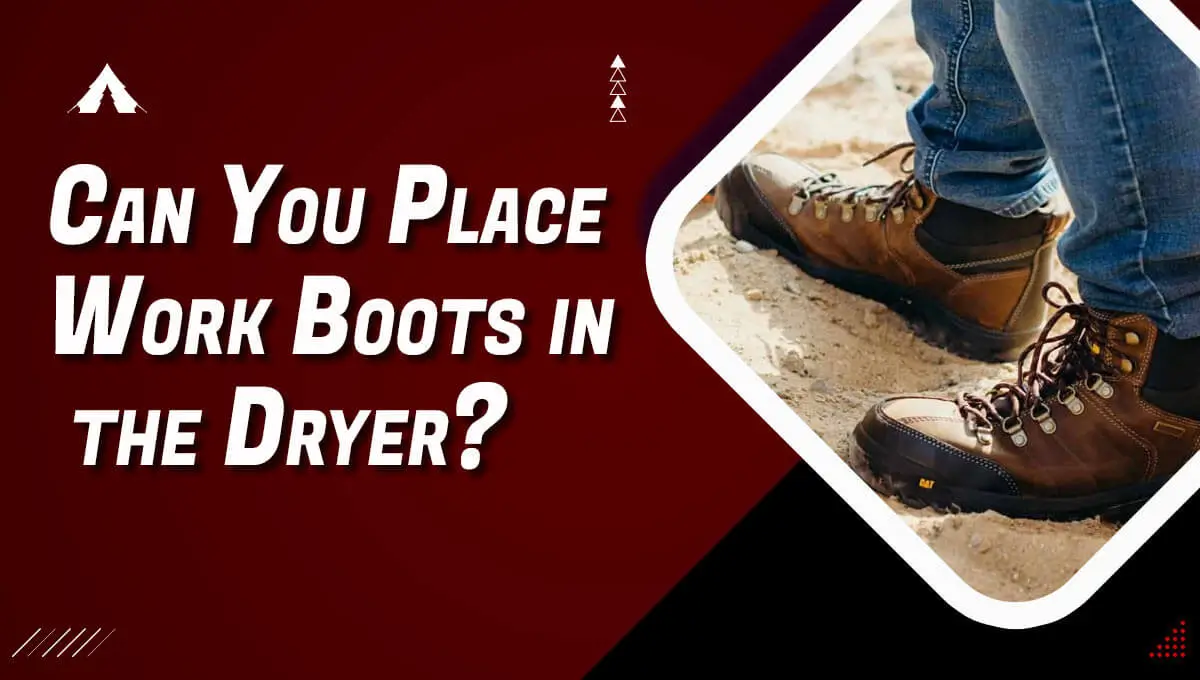Work boots are a fundamental necessity for individuals engaged in demanding jobs, such as construction, landscaping, and other physically strenuous professions. These boots are specifically designed to offer comfort, support, and safety. Over time, work boots accumulate dirt and odors due to the demanding work environments they are exposed to. This often leads people to wonder whether it is safe to use a dryer to freshen up their work boots or expedite the drying process. This article will explore the feasibility of placing work boots in the dryer, the potential consequences, and alternative methods for drying and maintaining your work boots.
Can You Place Work Boots in the Dryer?
In a nutshell, putting your work boots in the dryer is not advisable. While a dryer is an effective and rapid way to dry various types of footwear, it is not suitable for work boots for the following reasons:
Material Damage:
The majority of work boots are crafted from leather or synthetic materials. Subjecting these materials to the dryer’s heat can make them brittle and prevent them from shrinking, decreasing durability and comfort. Leather boots, mainly, are susceptible to cracking and losing their natural oils when exposed to high heat.
Structural Distortion:
The intense heat generated by a dryer can result in structural elements of your work boots, such as toe caps or shanks, becoming warped, reducing the support and protection they offer.
Weakening of Adhesives:
The adhesives used in the construction of work boots can weaken or melt when subjected to high temperatures, potentially leading to the separation of the sole from the boot’s upper.
Fire Hazard:
Excessive heat can pose a fire hazard, especially if your boots have metal components like steel toe caps.
Noise and Dryer Wear:
Inserting heavy work boots in a dryer can generate loud noises and potentially damage the dryer itself, which could result in costly repairs or replacements.
What to Do Instead:
Now that we have established that using a dryer is not the ideal method to dry your work boots, here are some alternative and practical strategies to safely and efficiently dry your shoes:
Air Drying:
The most recommended approach for drying work boots is to let them air dry at room temperature. Remove the insoles and open the shoes as much as possible to facilitate air circulation. Position them in a well-ventilated area, away from direct heat sources or direct sunlight. This method may take some time, but it is gentle on your boots and contributes to their long-lasting quality.
Boot Dryers:
Boot dryers are specifically designed to dry footwear safely. They employ gentle air circulation to expedite drying without exposing your boots to excessive heat. Investing in a boot dryer is wise for those who regularly wear work boots.
Moisture Removal:
Use dry towels or newspaper to eliminate excess moisture to hasten the drying process. Stuff your boots with newspaper to absorb moisture, and change the newspaper regularly. This approach can significantly reduce drying time.
Boot Trees:
Boot trees help maintain the shape of your work boots while they dry. They are especially beneficial for leather boots, preventing them from losing their form during drying.
Odor Control:
To combat unpleasant odors, sprinkle baking soda inside your boots or use odor-fighting insoles. These solutions effectively absorb moisture and help keep your shoes smelling fresh.
Waterproofing:
Consider applying a high-quality waterproofing spray to protect your boots from excessive moisture in the first place.
Maintenance Tips for Work Boots:
Proper care and maintenance of your work boots can significantly extend their lifespan and keep them in excellent condition. Here are additional tips to consider:
Regular Cleaning:
Consistently clean your boots to remove dirt, grime, and sweat. Use a soft brush and a damp cloth to wipe them down. Apply a leather cleaner and conditioner for leather boots to maintain suppleness and appearance.
Rotation:
If you possess multiple pairs of work boots, consider rotating them to allow each pair to air out and recover between uses.
Resoling When Necessary:
When the soles of your boots show signs of wear and tear, contemplate having them professionally resoled. This can extend the life of your preferred work boots.
Proper Storage:
Store your work boots in an excellent, dry location. Avoid leaving them in direct sunlight or damp areas.
Regular Inspections:
Periodically inspect your boots for wear, damage, or loose stitching. Promptly address any issues to prevent them from worsening.
Also Read How to Break in Military Boots?
Conclusion:
In conclusion, while using a dryer may seem convenient for drying work boots, it is generally not advisable. The heat from the dryer can harm the materials, weaken adhesives, and even present a fire hazard. Instead, opt for safer and more effective methods such as air drying, boot dryers, and absorbing materials to remove excess moisture.
Properly caring for your work boots through regular cleaning, maintenance, and suitable storage is essential to ensure they serve you well for an extended period. By adhering to these recommendations, you can keep your work boots in superb condition, offering the support and comfort necessary for your demanding profession.
Frequently Asked Questions:
How do you dry boots in a tumble dryer?
Never put boots in a tumble dryer. It can damage them! Remove insoles and laces to dry boots, then stuff them with newspaper to absorb moisture. Let them air-dry in a cool, dry place. A tumble dryer can shrink or distort the boots and harm their structure.
Are boot dryers safe?
Yes, boot dryers are generally safe when used as directed. They’re designed to gently and efficiently remove moisture from boots, helping prevent odors and mold. Always follow the manufacturer’s instructions, and avoid using excessive heat, which could damage certain materials. Proper use ensures both safety and effective drying.

